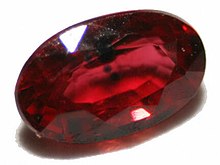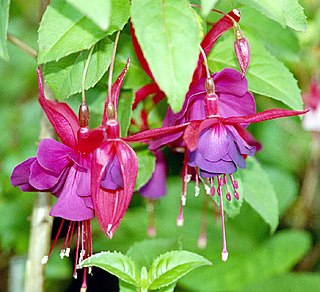
Fuchsia is a vivid pinkish-purplish-red color, named after the color of the flower of the fuchsia plant, which was named by a French botanist, Charles Plumier, after the 16th-century German botanist Leonhart Fuchs.

Lavender is a light shade of purple or violet. It applies particularly to the color of the flower of the same name. The web color called lavender is displayed at right—it matches the color of the very palest part of the lavender flower; however, the more saturated color shown below as floral lavender more closely matches the average color of the lavender flower as shown in the picture and is the tone of lavender historically and traditionally considered lavender by the average person as opposed to those who are website designers. The color lavender might be described as a medium purple or a light pinkish-purple. The term lavender may be used in general to apply to a wide range of pale, light or grayish-purples but only on the blue side. Lilac is pale purple on the pink side. In paints, the color lavender is made by mixing purple and white paint.

Copper is a reddish brown color that resembles the metal copper.
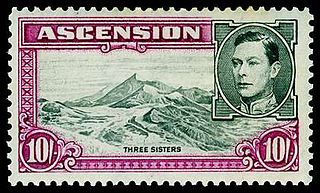
Red-violet refers to a rich color of high medium saturation about 3/4 of the way between red and magenta, closer to magenta than to red. In American English, this color term is sometimes used in color theory as one of the purple colors—a non-spectral color between red and violet that is a deep version of a color on the line of purples on the CIE chromaticity diagram.
Mahogany is a reddish-brown color. It is approximately the color of the wood mahogany. However, the wood itself, like most woods, is not uniformly the same color and is not recognized as a color by most.
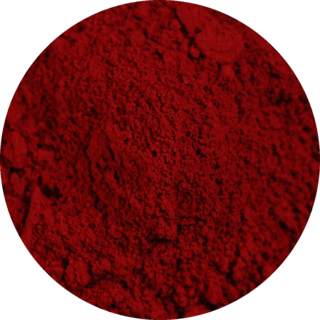
Carmine color is the general term for some deep red colors that are very slightly purplish but are generally slightly closer to red than the color crimson is. Some rubies are colored the color shown below as rich carmine. The deep dark red color shown at right as carmine is the color of the raw unprocessed pigment, but lighter, richer, or brighter colors are produced when the raw pigment is processed, some of which are shown below.
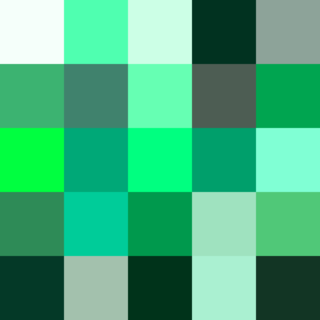
Spring green is a color that was traditionally considered to be on the yellow side of green, but in modern computer systems based on the RGB color model is halfway between cyan and green on the color wheel.

Sapphire is a saturated shade of blue, referring to the gem of the same name. Sapphire gems are most commonly found in a range of blue shades although they can be many different colors. Other names for variations of the color sapphire are blue sapphire or sapphire blue, shown below.

Amaranth is a reddish-rose color that is a representation of the color of the flower of the amaranth plant. The color shown is the color of the red amaranth flower, but there are other varieties of amaranth that have other colors of amaranth flowers; these colors are also shown below.
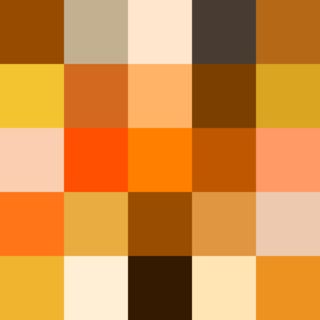
In optics, orange has a wavelength between approximately 585 and 620 nm and a hue of 30° in HSV color space. In the RGB color space it is a secondary color numerically halfway between gamma-compressed red and yellow, as can be seen in the RGB color wheel. The complementary color of orange is azure. Orange pigments are largely in the ochre or cadmium families, and absorb mostly blue light.
Spring bud is the color that used to be called spring green before the X11 web color spring green was formulated in 1987 when the X11 colors were first promulgated. This color is now called spring bud to avoid confusion with the web color.
Jungle green is a color that is a rich tone of medium spring green.

Varieties of the color red may differ in hue, chroma or lightness, or in two or three of these qualities. Variations in value are also called tints and shades, a tint being a red or other hue mixed with white, a shade being mixed with black. A large selection of these various colors is shown below.

Bronze is a metallic brown color which resembles the metal alloy bronze.

The color magenta has notable tints and shades. These various colors are shown below.
Livid is a medium bluish-gray color. This color name comes from the Latin color term lividus meaning "'a dull leaden-blue color', and also used to describe the color of contused flesh, leading to the English expression 'black and blue'". The first recorded use of livid as a color name in English was in 1622.

Shades of white are colors that differ only slightly from pure white. Variations of white include what are commonly termed off-white colors, which may be considered part of a neutral color scheme or yellow that looks like brown.

The color cyan, a greenish-blue, has notable tints and shades. It is one of the subtractive primary colors along with magenta, and yellow.

Shades of black are colors that differ only slightly from pure black. These colors have a low lightness. From a photometric point of view, a color which differs slightly from black always has low relative luminance. Variations of black include what are commonly termed off-black colors, which may be considered part of a neutral color scheme, usually in interior design as a part of a background for brighter colors. Black and dark gray colors are powerful accent colors that suggest weight, dignity, formality, and solemnity.

Rose is the color halfway between red and magenta on the HSV color wheel, also known as the RGB color wheel, on which it is at hue angle of 330 degrees.
